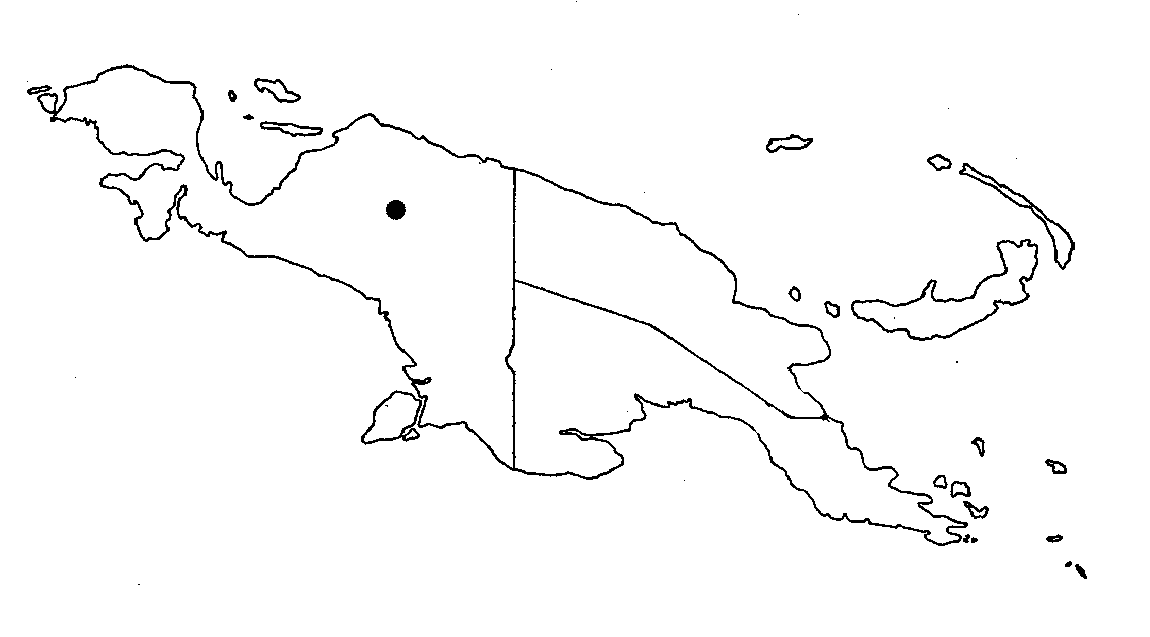
Distribution Map

Description (Barlow 1992)
Loranthus cercidioides Krause, Nova Guinea 14 (1923) 103. - Amyema cercidioides (Krause) Danser, Bull. Jard. Bot Buitenzorg III, 10 (1929) 294. - Type: Lam 1893 (holo L 926,134-985; iso K, U 78803), New Guinea, Doorman Top, 1450 m, 3.xi.1920.
For description see Danser, Bull. Jard. Bot Buitenzorg III, 11
(1931) 329; Barlow, Austral. J. Bot. 22 (1974) 570. The species
can be identified locally by its combination of opposite sessile
leaves cordate at the base, inflorescence with a short peduncle
and few umbel rays, and flowers all sessile in the triads.
Amyema cercidioides is still known only through the type
specimen from the New Guinean highlands (fig. 4). Habitat details
and hosts are unknown. The species is a differentiate of the A.
scandens species complex. Because of the extreme polymorphy
of this complex, the lack of further collections of A. cercidioides
raises some doubt about its taxonomic status. Amyema caudiciflora
in particular has a discrete area in the highlands of New
Guinea and is distinguished by its thick, sessile leaves. Whilst
A. cercidioides may be an extreme form of this entity,
its distinctive opposite leaves with cordate base suggest a level
of differentiation consistent with specific status. See notes
under A. scandens andA. caudiciflora.
Description (Barlow 1974)
Amyema cercidioides (Krause) Dans. Bull. Jard. bot. Buitenz. 10: 294 (1929); 11: 329 (1931); Loranthus cercidjoides Krause, Nov. Guin. 14: 103 (1923). Type-Doorman Top, 1450 m alt., Lam 1893, 3.xi.1920 (L 926134985, holotype; K; U 78803).
Stems leaves and infiorescences covered with very short thick simple hairs; flowers glabrous. Leaves opposite, sessile; lamina almost orbicular, thick, 9-12 by 8-10 cm, dull on both sides, cordate at the base, rounded at the apex; venation pennate with the lateral veins as prominent as the midrib and arising near its base. Inflorescences only seen detached; peduncle 5 mm long, 2 mm thick; rays 3 or 4, 6 mm long, 2 mm wide at the base, 3 mm wide at the apex; triads with all flowers sessile; bracts spread-ing, obtuse, c. 2 mm by 2 mm, shortly united at the margins into an involucre below the triad. Calyx spindle-shaped to urceolate, smooth except for one or more weak longitudinal ribs or angles; limb erect, c. 1 mm long with 6 narrow acute teeth c. 05 mm long. Corolla in immature bud cylindrical, 6-merous, not seen mature. Anthers shorter than the free parts of the filaments, not seen mature. Style persistent on the fruit for some time; stigma small. Fruit urceolate, c. 8 mm long, sometimes weakly ribbed like the calyx, crowned by the persistent calyx limb. (Fig. 5, f)
Occurrence. West Irian, known from Doorman Top only (Fig. 2), 1450 m altitude.
Specimen Examined. WEST IRIAN: Doorman Top, 1450 m alt., Lam 1893, 3.xi.1920 (L; K; U).
See note under A. scandens.
Illustrations

Amyema cercidioides. Leaf lamina. From Barlow (1974).
Photographs
Amyema cercidioides
updated 18 January 2007